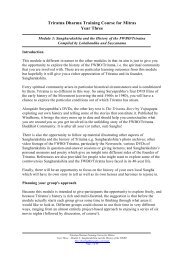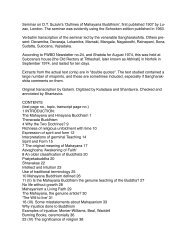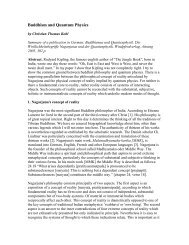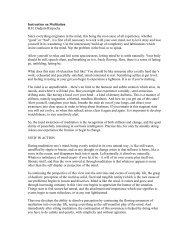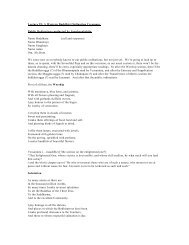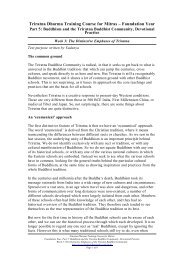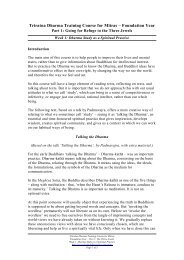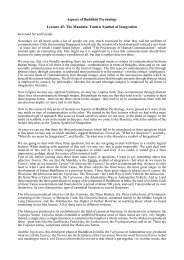Great Buddhists from Triratna Refuge Tree - Free Buddhist Audio
Great Buddhists from Triratna Refuge Tree - Free Buddhist Audio
Great Buddhists from Triratna Refuge Tree - Free Buddhist Audio
Create successful ePaper yourself
Turn your PDF publications into a flip-book with our unique Google optimized e-Paper software.
solution to this problem was a change in religion. It wasn‟t enough just to reject<br />
Hinduism, just to leave the religion that generally condoned the caste system.<br />
Ambedkar himself was a deeply religious man; he believed that religion was<br />
essential to human life, that we cannot really live without it. So for him there was<br />
no question of pursuing, for instance, the communist option. He believed that a<br />
real social and economic revolution was possible only on the basis of a spiritual<br />
revolution.<br />
It was for this reason that he inaugurated what we now call the „Dhamma<br />
revolution‟. This is not just a nominal change of religion, but a transformation of<br />
one‟s whole life in every aspect. It is not just individual transformation, but even<br />
collective transformation as well. This is the movement that Ambedkar set in<br />
motion. He showed that a change in religion, even in the midst of the twentieth<br />
century, could bring about a change for the better in the lives of millions of<br />
people.<br />
The conversion movement in India is also of profound significance for Buddhism<br />
itself. Ambedkar was well aware that Buddhism had already disappeared once<br />
<strong>from</strong> India, and having revived it he didn‟t want it to disappear again. So he<br />
looked at why it had disappeared. He saw that one of the principal factors leading<br />
to its decline was the separation which had developed between the monks and the<br />
laity.<br />
The monks lived together in monasteries, and in the course of centuries these<br />
monasteries became bigger and bigger, each in the end housing thousands of<br />
monks leading self-contained lives apart <strong>from</strong> the laity. So without much contact<br />
with the monks and without any lay ordination, the lay-people began to feel less<br />
and less like they themselves were <strong><strong>Buddhist</strong>s</strong> at all, and they came more and more<br />
under the influence of the Hindu brahmins. And this process was accelerated after<br />
the great monasteries were destroyed by Muslim invaders in the tenth, eleventh,<br />
and twelfth centuries. Thus eventually, the lay <strong><strong>Buddhist</strong>s</strong> were simply absorbed<br />
into the Hindu community. Buddhism disappeared <strong>from</strong> India, and only ruins<br />
marked what it once had been.<br />
On the basis of this analysis of the decline and fall of Indian Buddhism, Ambedkar<br />
decided that there had to be ordination for lay-people corresponding to monastic<br />
ordination for monks. He called this lay ordination „Dhammadiksha‟, and it<br />
consisted of two parts: first, taking the traditional Three <strong>Refuge</strong>s and five<br />
precepts; and secondly – and this was quite new – taking twenty-two vows.<br />
These twenty-two vows were devised by Ambedkar himself, and their purpose was<br />
to clearly and completely separate the new <strong><strong>Buddhist</strong>s</strong> <strong>from</strong> their old Hindu<br />
religion. They constituted an explicit renunciation of every vestige of Hinduism,<br />
of every Hindu practice, like, for example, offering animal sacrifices to gods and<br />
goddesses. These vows made it clear what it was to be a Hindu and what it was to<br />
be a <strong>Buddhist</strong>, and that it was not possible to be both. They helped to root out a<br />
very commonly held belief in India at this time that if you were a <strong>Buddhist</strong> you<br />
were necessarily also a Hindu, that Buddhism was an accretion on the main body<br />
of Hinduism. I myself remember a Hindu swami asking me after my ordination<br />
<strong>Triratna</strong> Dharma Training Course for Mitras<br />
Year Four, Module 7: <strong>Great</strong> <strong><strong>Buddhist</strong>s</strong> <strong>from</strong> the <strong>Refuge</strong> <strong>Tree</strong> of the <strong>Triratna</strong> <strong>Buddhist</strong> Order<br />
http://freebuddhistaudio.com/study<br />
Page 16 of 42



